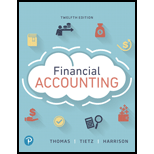
Concept explainers
LO 1, 2, 3, 4
(Learning Objectives 1, 2, 3, 4: Measure and report current liabilities) At December 31, 2018, Filbert Corporation’s adjusted
| Accrued Warranty Payable | $ 58,000 |
| 4% Notes Payable, due April 30, 2019 | 150,000 |
| Unearned Service Revenue | 48,000 |
| Accounts Payable | 225,000 |
| Employee Income Tax Payable | 27,000 |
| 279,000 | |
| Interest Payable | 29,000 |
| 8% Bonds Payable, due December 31, 2023 | 500,000 |
| 75,000 | |
| 164,000 | |
| Salaries Payable | 84.000 |
| 5% Notes Payable, due December 31, 2019 | 200,000 |
| Sales Tax Payable | 67,000 |
| FICA Tax Payable | 7,000 |
Filbert Corporation provides multi-year warranties with its products. Half of the Accrued Warranty Liability relates to warranty liabilities that will be paid in 2019, while the other half relates to warranty liabilities to be paid in 2020. The Unearned Service Revenue pertains to a service contract that will be performed during 2019. $100,000 of the 8% bonds payable due December 31, 2023, is due on December 31. 2019.
Requirement
1. Prepare the current liability section of Filbert Corporation’s
Want to see the full answer?
Check out a sample textbook solution
Chapter 8 Solutions
Financial Accounting (12th Edition) (What's New in Accounting)
- Kindly help me with accounting questionsarrow_forwardDuo Corporation is evaluating a project with the following cash flows: Year 0 1 2 3 Cash Flow -$ 30,000 12,200 14,900 16,800 4 5 13,900 -10,400 The company uses an interest rate of 8 percent on all of its projects. a. Calculate the MIRR of the project using the discounting approach. Note: Do not round intermediate calculations and enter your answer as a percent rounded to 2 decimal places, e.g., 32.16. b. Calculate the MIRR of the project using the reinvestment approach. Note: Do not round intermediate calculations and enter your answer as a percent rounded to 2 decimal places, e.g., 32.16. c. Calculate the MIRR of the project using the combination approach. Note: Do not round intermediate calculations and enter your answer as a percent rounded to 2 decimal places, e.g., 32.16. a. Discounting approach MIRR b. Reinvestment approach MIRR c. Combination approach MIRR % % %arrow_forwardHello tutor please provide this question solution general accountingarrow_forward
- Need help with this question solution general accountingarrow_forwardConsider a four-year project with the following information: Initial fixed asset investment = $555,000; straight-line depreciation to zero over the four-year life; zero salvage value; price = $37; variable costs = $25; fixed costs = $230,000; quantity sold = 79,000 units; tax rate = 24 percent. How sensitive is OCF to changes in quantity sold?arrow_forwardLight emitting diodes (LED) light bulbs have become required in recent years, but do they make financial sense? Suppose a typical 60-watt incandescent light bulb costs $.39 and lasts 1,000 hours. A 15-watt LED, which provides the same light, costs $3.10 and lasts for 12,000 hours. A kilowatt-hour of electricity costs $.115. A kilowatt-hour is 1,000 watts for 1 hour. If you require a return of 11 percent and use a light fixture 500 hours per year, what is the equivalent annual cost of each light bulb? Note: A negative answer should be indicated by a minus sign. Do not round intermediate calculations and round your answers to 2 decimal places, e.g., 32.16.arrow_forward
- Principles of Accounting Volume 1AccountingISBN:9781947172685Author:OpenStaxPublisher:OpenStax College
